A Nanocomposite Paste Electrode Sensor for Simultaneous Detection of Uric Acid and Bisphenol A Using Zinc Hydroxide Nitrate-Sodium Dodecylsulfate Bispyribac
Abstract
:1. Introduction
2. Materials and Methods
2.1. Chemicals and Reagents
2.2. Instruments
2.3. Preparation of ZHN-SDS-BP Nanocomposite
2.4. Preparation of the MWCNTs/ZHN-SDS-BP Electrode
2.5. Measurements of UA and BPA
2.6. Preparation of Real Sample Analysis
3. Results and Discussion
3.1. Morphological Studies and Electrochemical Characterization
3.2. Electrochemical Responses of UA and BPA
3.3. Optimization of Variables of ZHN-SDS-BP/MWCNT Paste Electrode
3.3.1. The Effect of ZHN-SDS-BP Composition Percentage
3.3.2. The Effect of Supporting Electrolyte Types
3.3.3. The Effect of pH on Supporting Electrolytes
3.3.4. The Effect of Square-Wave Voltammetry Parameters
3.4. Chronocoulometric Studies
3.5. Calibration Data, Limit of Detection, Reproducibility, Repeatability, and Stability
3.6. Interferences Studies
3.7. Real Sample Analysis
4. Conclusions
Supplementary Materials
Author Contributions
Funding
Institutional Review Board Statement
Informed Consent Statement
Data Availability Statement
Acknowledgments
Conflicts of Interest
References
- Lakshmi, D.; Whitcombe, M.J.; Davis, F.; Sharma, P.S.; Prasad, B.B. Electrochemical Detection of Uric Ucid in Mixed and Clinical Samples: A review. Electroanalysis 2011, 23, 305–320. [Google Scholar] [CrossRef]
- Erden, P.E.; Kiliç, E. A Review of Enzymatic Uric Acid Biosensors Based on Amperometric Detection. Talanta 2013, 107, 312–323. [Google Scholar] [CrossRef]
- Beitollahi, H.; Hamzavi, M.; Torkzadeh-Mahani, M.; Shanesaz, M.; Maleh, H.K. A Novel Strategy for Simultaneous Determination of Dopamine and Uric Acid using a Carbon Paste Electrode Modified with CdTe Quantum Dots. Electroanalysis 2015, 27, 524–533. [Google Scholar] [CrossRef]
- Shi, R.; Liang, J.; Zhao, Z.; Liu, A.; Tian, Y. An Electrochemical Bisphenol A Sensor Based on One Step Electrochemical Reduction of Cuprous Oxide Wrapped Graphene Oxide Nanoparticles Modified Electrode. Talanta 2017, 169, 37–43. [Google Scholar] [CrossRef]
- Matsumoto, K.; Tiu, B.D.B.; Kawamura, A.; Advincula, R.C.; Miyata, T. QCM Sensing of Bisphenol A using Molecularly Imprinted Hydrogel/Conducting Polymer Matrix. Polym. J. 2016, 48, 525–532. [Google Scholar] [CrossRef]
- Amiri-Aref, M.; Raoof, J.B.; Ojani, R. Utilization of a Bioactive Anthocyanin for the Fabrication of a Novel Carbon Nanotube-Based Electrochemical Sensor and its Electrocatalytic Properties for Selective Determination of L-dopa in the Presence of Uric Acid. Ionics 2016, 22, 125–134. [Google Scholar] [CrossRef]
- Song, H.; Xue, G.; Zhang, J.; Wang, G.; Ye, B.C.; Sun, S.; Tian, L.; Li, Y. Simultaneous Voltammetric Determination of Dopamine and Uric Acid using Carbon-Encapsulated Hollow Fe3O4 Nanoparticles Anchored to an Electrode Modified with Nanosheets of Reduced Graphene Oxide. Microchim. Acta 2017, 184, 843–853. [Google Scholar] [CrossRef]
- Zhang, X.; Zhang, Y.C.; Ma, L.X. One-Pot Facile Fabrication of Graphene-Zinc Oxide Composite and its Enhanced Sensitivity for Simultaneous Electrochemical Detection of Ascorbic Acid, Dopamine and Uric Acid. Sens. Actuators B 2016, 227, 488–496. [Google Scholar] [CrossRef]
- Rozhin, D.; Hassan, K.M.; Merve, A.; Kubilay, A.; Zhouxiang, Z.; Ramazan, B.; Muhammed, B.; Fatih, S. Simultaneous Determination of Ascorbic Acid, Dopamine, and Uric Acid with a Highly Selective and Sensitive Reduced Graphene Oxide/ Polypyrrole-Platinum Nanocomposite Modified Electrochemical Sensor. Electrochim. Acta 2023, 457, 142402. [Google Scholar]
- Haoye, W.; Aijuan, X.; Shuji, L.; Jiajun, W.; Kaixuan, C.; Zilong, S.; Ningning, S.; Shiping, L. Three-Dimensional g-C3N4/MWNTs/GO Hybrid Electrode as Electrochemical Sensor for Simultaneous Determination of Ascorbic Acid, Dopamine and Uric Acid. Anal. Chim. Acta 2022, 1211, 339907. [Google Scholar]
- Yonghui, X.; Guangli, L.; Yuefang, Z.; Quanguo, H.; Changping, H. Facile Preparation of Metal-Free Graphitic-Like Carbon Nitride/Graphene Oxide Composite for Simultaneous Determination of Uric Acid and Dopamine. Microchem. J. 2023, 190, 108726. [Google Scholar]
- Xianyu, K.; Yingying, S.; Jingchuang, Z.; Yancai, L. Simultaneous Determination of Paracetamol and Dopamine, and Detection of Bisphenol A using Three-Dimensional Interconnected Porous Carbon Functionalized with Ionic Liquid. J. Electroanal. Chem. 2021, 895, 115482. [Google Scholar]
- Min, Y.K.; Kyeong, D.S.; Honghyun, P.; Rabbee, G.M.; Kyu, H.L.; Yoon, B.S. Graphene-Anchored Conductive Polymer Aerogel Composite for the Electrocatalytic Detection of Hydrogen Peroxide and Bisphenol A. Appl. Surf. Sci. 2022, 604, 154430. [Google Scholar]
- Min, Y.K.; Honghyun, P.; Ju, Y.L.; Da, J.P.; Joo, Y.L.; Nosang, V.M.; Kyu, H.L. Hierarchically Palladium Nanoparticles Embedded Polyethyleneimine–Reduced Graphene Oxide Aerogel (RGA–PEI–Pd) Porous Electrodes for Electrochemical Detection of Bisphenol A and H2O2. Chem. Eng. J. 2022, 431, 134250. [Google Scholar]
- Sharif, S.N.M.; Hashim, N.; Isa, I.M.; Bakar, S.A.; Saidin, M.I.; Ahmad, M.S.; Mamat, M.; Hussein, M.Z.; Zainul, R. Chitosan as a Coating Material in Enhancing the Controlled Release Behaviour of Zinc Hydroxide Nitrate–Sodium Dodecylsulphate–Bispyribac Nanocomposite. Chem. Pap. 2021, 75, 611–627. [Google Scholar] [CrossRef]
- Sharif, S.N.M.; Hashim, N.; Isa, I.M.; Bakar, S.A.; Saidin, M.I.; Ahmad, M.S.; Mamat, M.; Hussein, M.Z. Controlled Release Formulation of Zinc Hydroxide Nitrate Intercalated with Sodium Dodecylsulphate and Bispyribac Anions: A Novel Herbicide Nanocomposite for Paddy Cultivation. Arab. J. Chem. 2020, 13, 4513–4527. [Google Scholar] [CrossRef]
- Magar, H.S.; Hassan, R.Y.A.; Mulchandani, A. Electrochemical Impedance Spectroscopy (EIS): Principles, Construction, and Biosensing Applications. Sensors 2021, 21, 6578. [Google Scholar] [CrossRef]
- Wong, A.; Razzino, C.A.; Silva, T.A.; Fatibello, F.O. Square-Wave Voltammetric Determination of Clindamycin using a Glassy Carbon Electrode Modified with Graphene Oxide and Gold Nanoparticles within a Crosslinked Chitosan Film. Sens. Actuators B 2016, 231, 183–193. [Google Scholar] [CrossRef]
- Ghiaci, M.; Rezaei, B.; Arshadi, M. Characterization of Modified Carbon Paste Electrode by using Salen Schiff Base Ligand Immobilized on SiO2-Al2O3 as a Highly Sensitive Sensor for Anodic Stripping Voltammetric Determination of Copper(II). Sens. Actuators B 2009, 139, 494–500. [Google Scholar] [CrossRef]
- Kalcher, K.; Kauffmann, J.M.; Wang, J.; Svancara, I.; Vytras, K.; Neuhold, C.; Yang, Z. Sensors Based on Carbon Paste in Electrochemical Analysis: A review with Particular Emphasis on the Period 1990–1993. Electroanalysis 1995, 7, 5. [Google Scholar] [CrossRef]
- Chen, Z.; Tang, C.; Zeng, Y.; Liu, H.; Yin, Z.; Li, L. Determination of Bisphenol A using an Electrochemical Sensor Based on a Molecularly Imprinted Polymer-Modified Multiwalled Carbon Nanotube Paste Electrode. Anal. Lett. 2014, 47, 996–1014. [Google Scholar] [CrossRef]
- Ahmadpour, S.; Tashkhourian, J.; Hemmateenejad, B. A Chemometric Investigation on the Influence of the Nature and Concentration of Supporting Electrolyte on Charging Currents in Electrochemistry. J. Electroanal. Chem. 2020, 871, 114296. [Google Scholar] [CrossRef]
- Ben, M.N.; Ghica, M.E.; Dridi, C.; Ben, A.M.; Brett, C.M.A. Electrochemical Sensor Based on Multiwalled Carbon Nanotube and Gold Nanoparticle Modified Electrode for the Sensitive Detection of Bisphenol A. Sens. Actuators B 2017, 253, 513–522. [Google Scholar]
- Raoof, J.B.; Ojani, R.; Baghayeri, M.; Ahmadi, F. Fabrication of a Fast, Simple and Sensitive Voltammetric Sensor for the Simultaneous Determination of 4-Aminohippuric Acid and Uric Acid using a Functionalized Multi-Walled Carbon Nanotube Modified Glassy Carbon Electrode. Anal. Methods 2012, 4, 1825–1832. [Google Scholar] [CrossRef]
- Anson, F.C.; Osteryoung, R.A. Chronocoulometry: A Convenient, Rapid and Reliable Technique for Detection and Determination of Adsorbed Reactants. J. Chem. Educ. 1983, 60, 293. [Google Scholar] [CrossRef]
- Zhang, X.; Ma, L.X.; Zhang, Y.C. Electrodeposition of Platinum Nanosheets on C60 Decorated Glassy Carbon Electrode as a Stable Electrochemical Biosensor for Simultaneous Detection of Ascorbic Acid, Dopamine and Uric Acid. Electrochim. Acta 2015, 177, 118–127. [Google Scholar] [CrossRef]
- Xu, T.Q.; Zhang, Q.L.; Zheng, J.N.; Lv, Z.Y.; Wei, J.; Wang, A.J.; Feng, J.J. Simultaneous Determination of Dopamine and Uric Acid in the Presence of Ascorbic Acid using Pt Nanoparticles Supported on Reduced Graphene Oxide. Electrochim. Acta 2014, 115, 109–115. [Google Scholar] [CrossRef]
- Huang, Y.; Li, X.; Zheng, S. A novel and Label-Free Immunosensor for Bisphenol A using Rutin as the Redox Probe. Talanta 2016, 160, 241–246. [Google Scholar] [CrossRef]
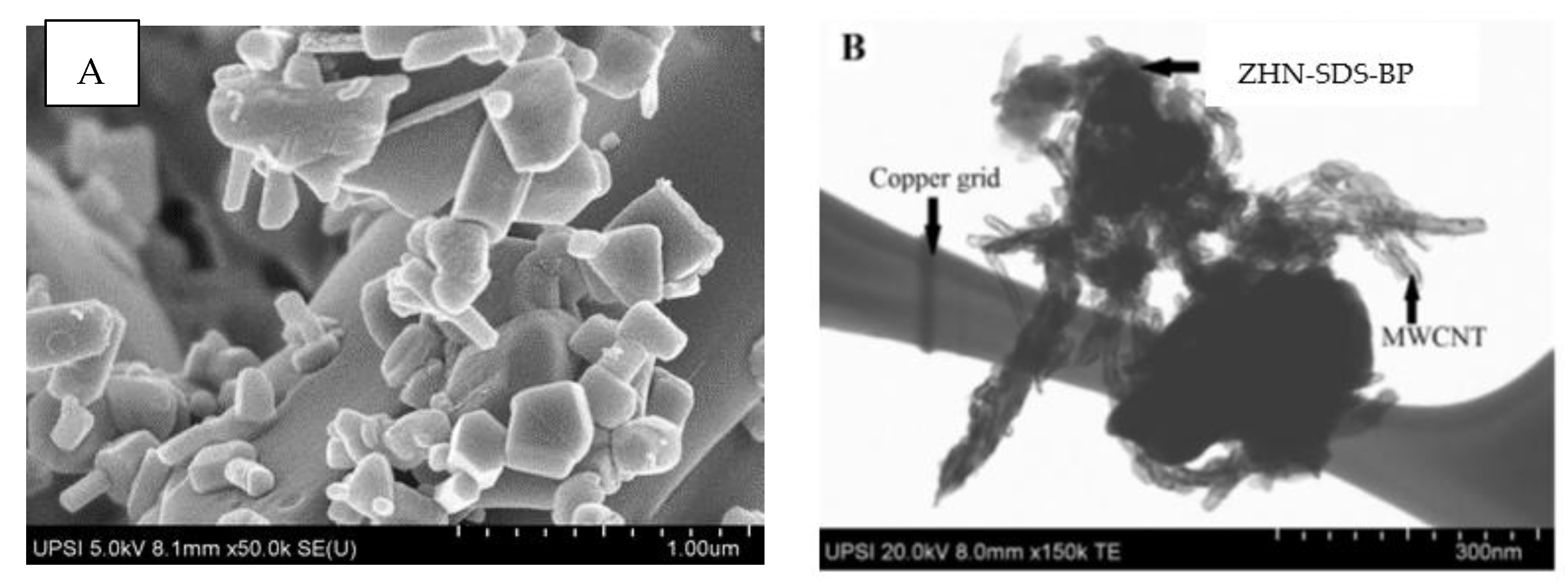
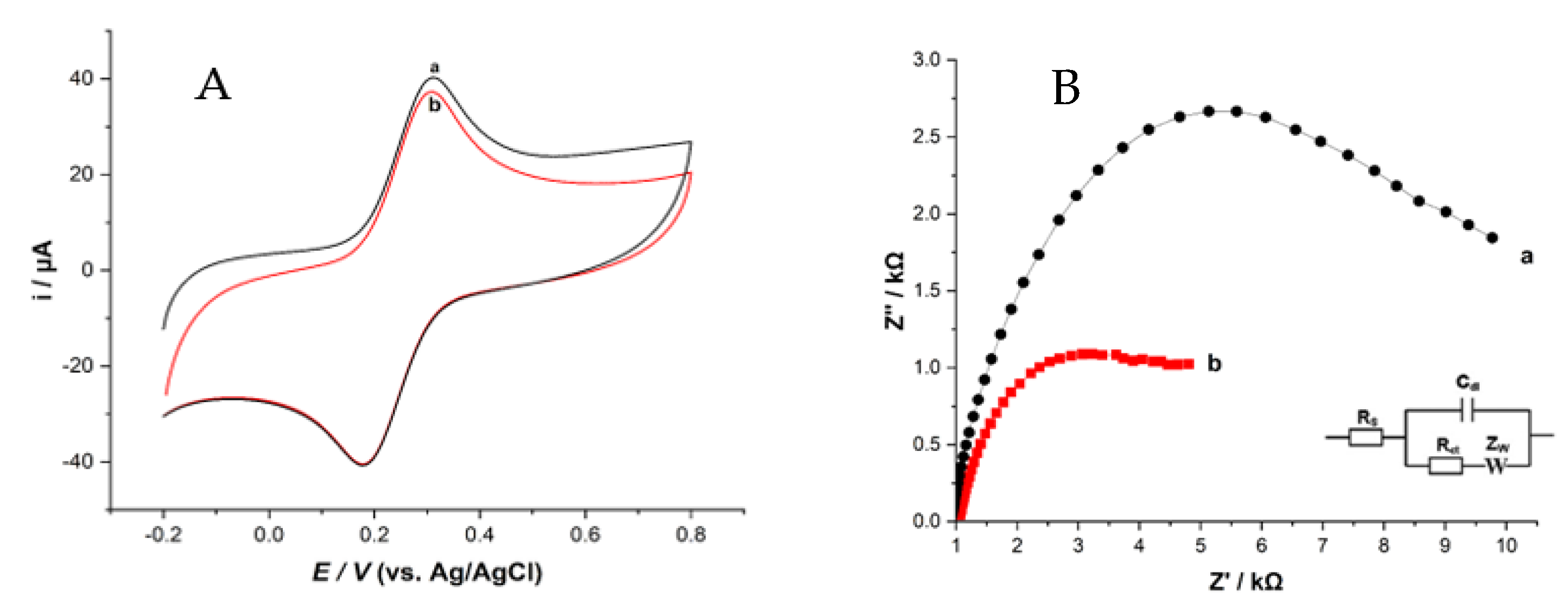

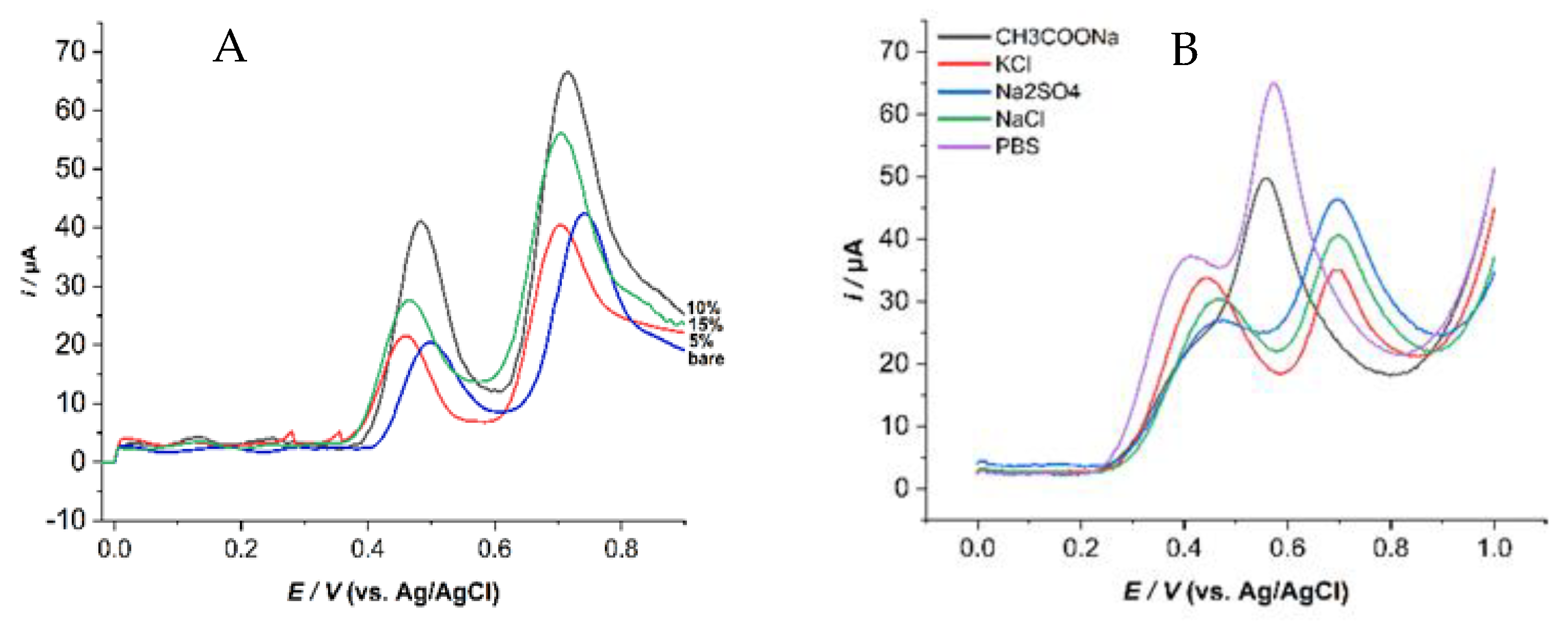
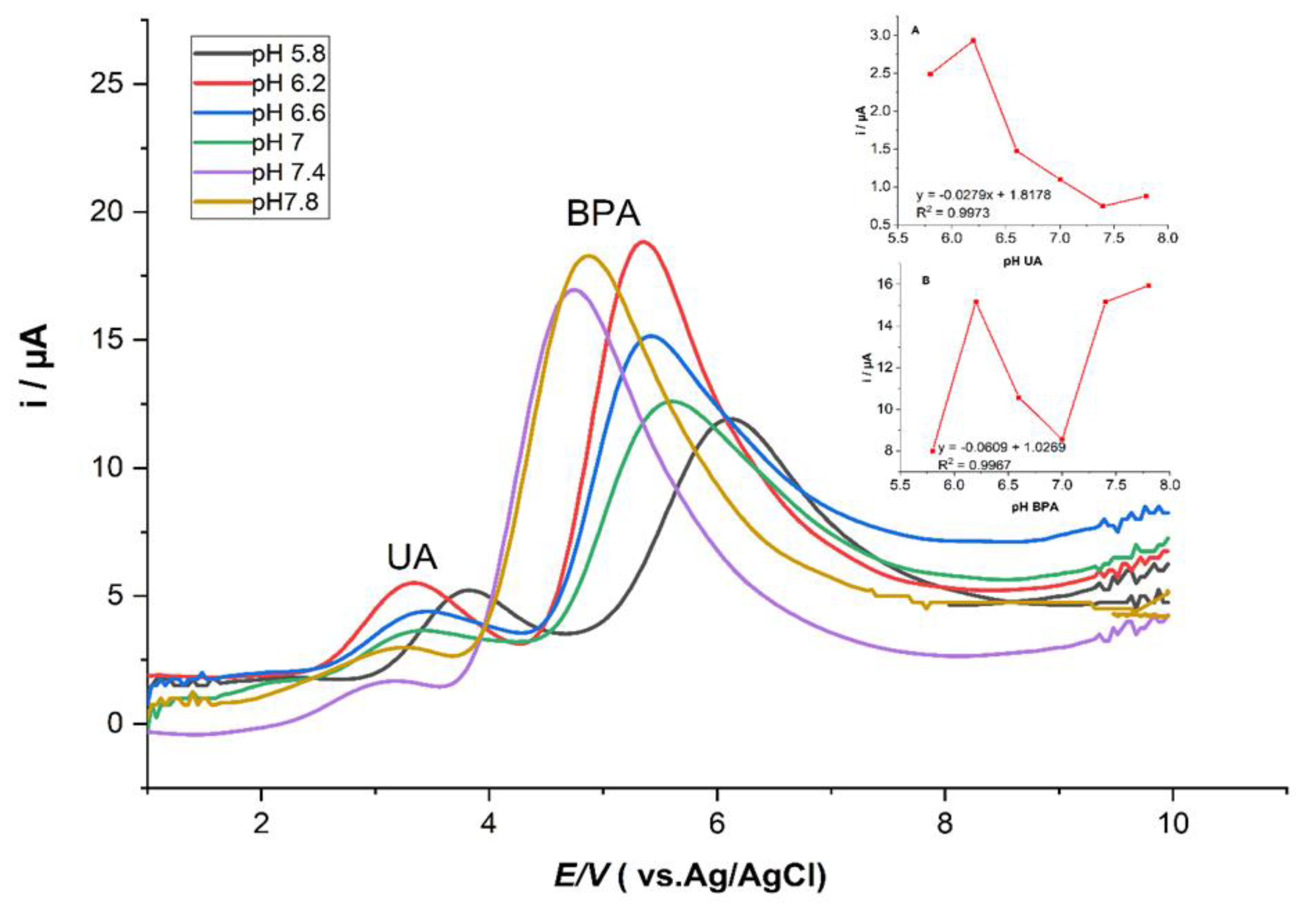


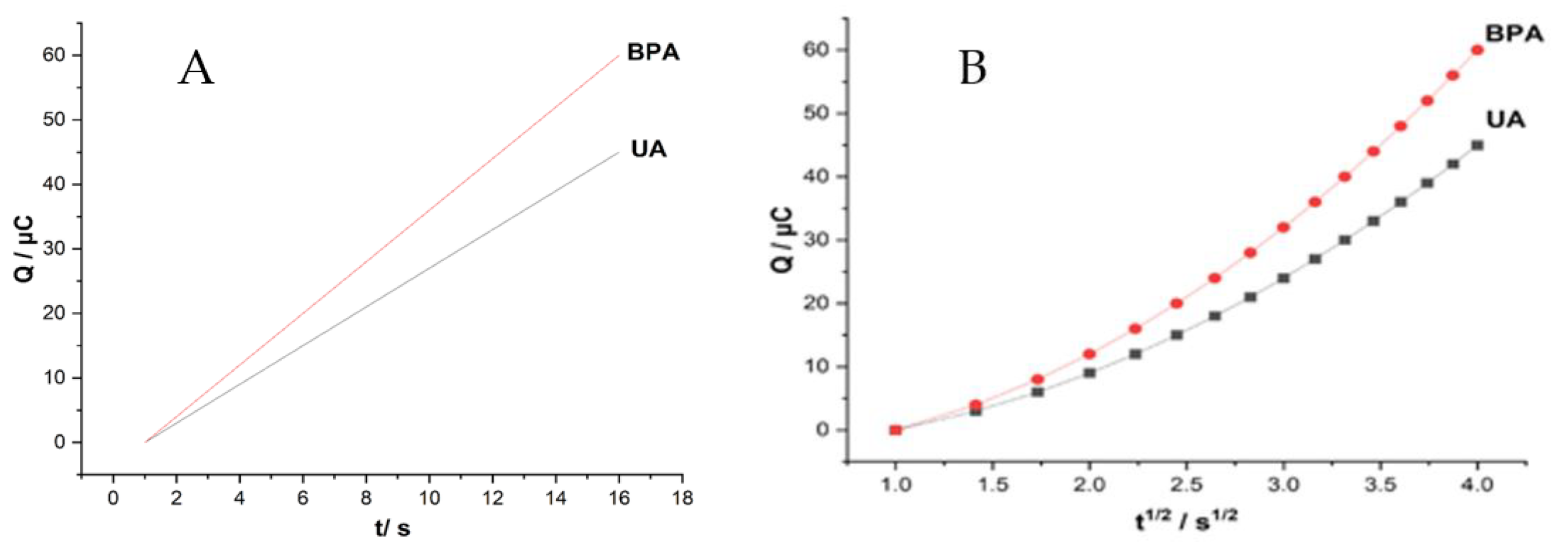
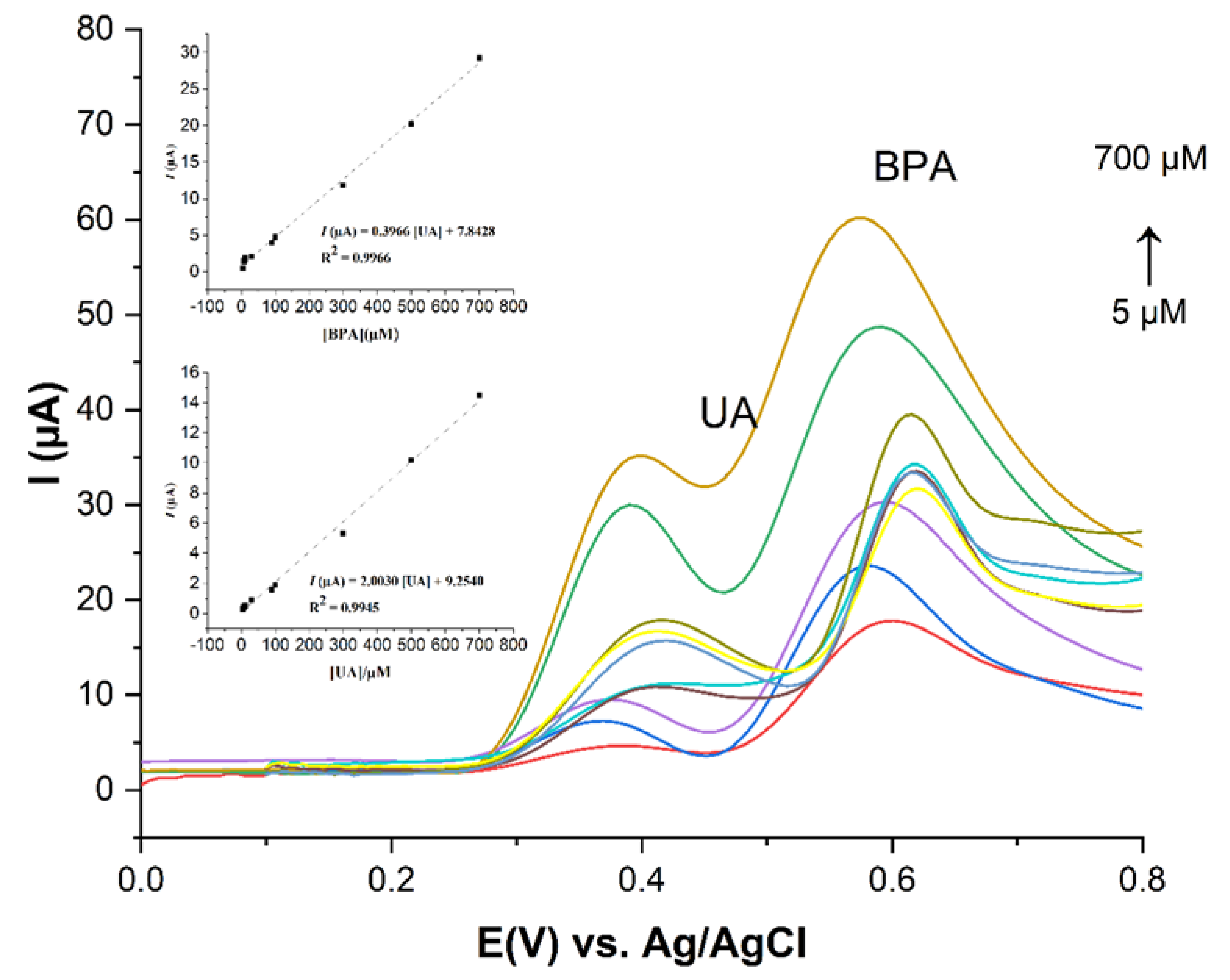
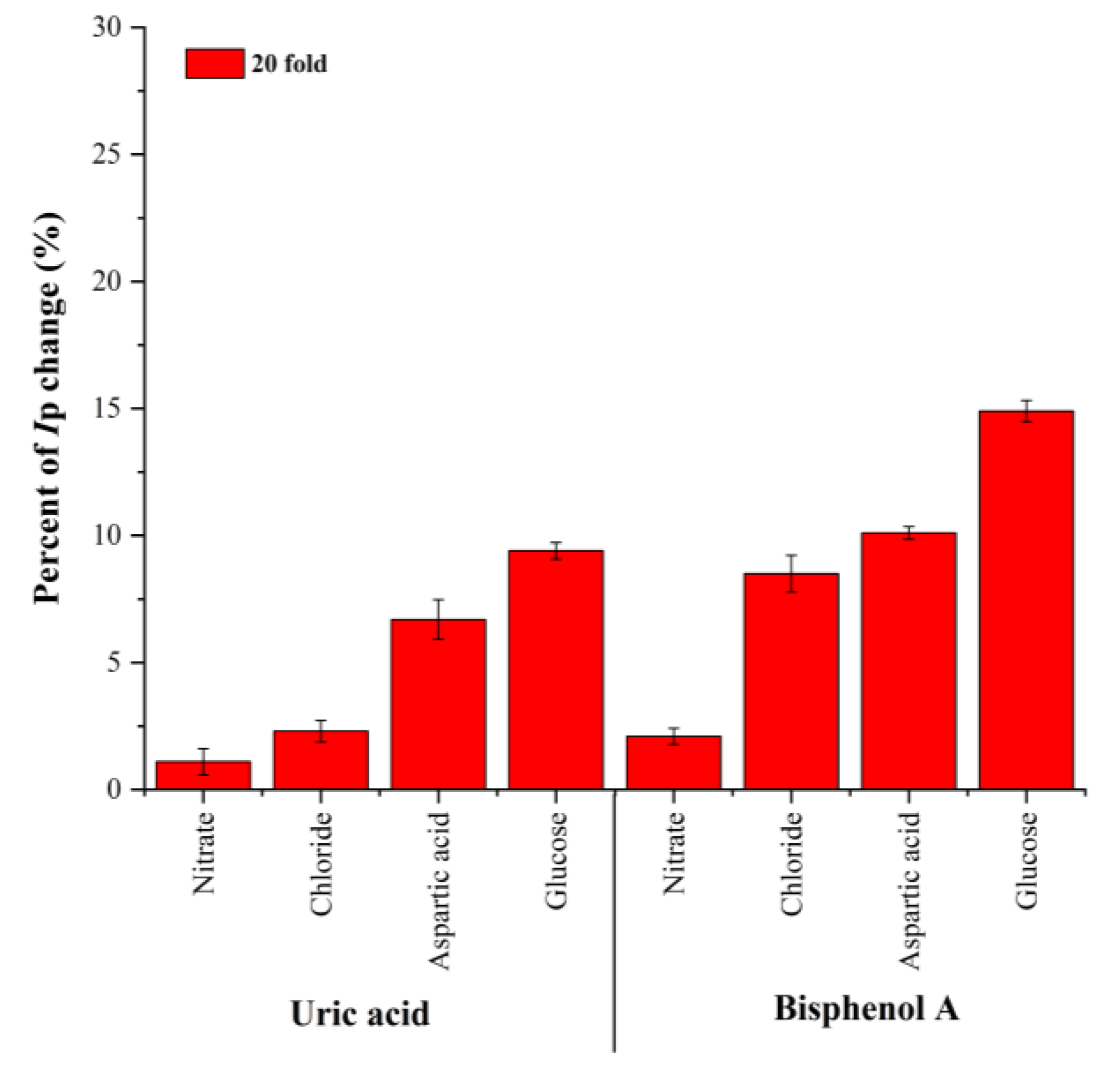

| Analyte | Modifier/Electrode | LWR (µM) | LOD (µM) | Ref. |
|---|---|---|---|---|
| UA + dopamine | Fe3O4/GO | 1–100; UA | 0.410 | [7] |
| UA + dopamine + ascorbic acid | Pt NSs/C60/GCE | 9.5–1187; UA | 0.630 | [26] |
| UA + dopamine + ascorbic acid | Pt/RGO | 10–130; UA | 0.450 | [27] |
| BPA + paracetamol + dopamine | IL/GCE | 2–100; BPA | 0.028 | [12] |
| BPA + H2O2 | Polyterthiophene aerogel/SPE | 1–200; BPA | - | [13] |
| BPA + H2O2 | Palladium/Polyethlyenimine aerogel/SPE | 1–500; BPA | 0.025 | [15] |
| BPA + UA | ZHN-SDS-BP/MWCNT | 5.0–700; UA, BPA | 0.371, 0.815 | This work |
| Sample | Detected (μM) | Added (μM) | Found (μM) | Recovery (%) | ||||
|---|---|---|---|---|---|---|---|---|
| UA | BPA | UA | BPA | UA | BPA | UA | BPA | |
| Urine 1 | 25.54 | N.D | 4.0 | 12.0 | 28.13 | 11.86 | 95.23 | 98.30 |
| Urine 2 | 24.10 | N.D | 4.0 | 12.0 | 26.64 | 10.97 | 94.80 | 91.41 |
| Lake water 1 | N.D | N.D | 10.0 | 10.0 | 8.91 | 9.33 | 89.10 | 93.30 |
| Lake water 2 | N.D | N.D | 10.0 | 10.0 | 9.56 | 9.61 | 95.60 | 96.10 |
| Samples | Method | Mean (µM) | Std. Deviation (µM) | Recovery (%) | Sig. (2-Tailed) | |
|---|---|---|---|---|---|---|
| Urine (UA) | SWV | 16.71 | 0.41 | 90.11 | 95.45 | |
| HPLC | 15.04 | 0.35 | 89.31 | 89.60 | 0.10 | |
| Lake water (BPA) | SWV | 20.01 | 0.57 | 83.67 | 91.10 | |
| HPLC | 19.14 | 0.40 | 89.77 | 92.71 | 0.17 | |
Disclaimer/Publisher’s Note: The statements, opinions and data contained in all publications are solely those of the individual author(s) and contributor(s) and not of MDPI and/or the editor(s). MDPI and/or the editor(s) disclaim responsibility for any injury to people or property resulting from any ideas, methods, instructions or products referred to in the content. |
© 2023 by the authors. Licensee MDPI, Basel, Switzerland. This article is an open access article distributed under the terms and conditions of the Creative Commons Attribution (CC BY) license (https://creativecommons.org/licenses/by/4.0/).
Share and Cite
Yulkifli, Y.; Yandes, W.P.; Isa, I.M.; Hashim, N.; Ulianas, A.; Sharif, S.N.M.; Saidin, M.I.; Ahmad, M.S.; Yazid, S.N.A.M.; Suyanta, S.; et al. A Nanocomposite Paste Electrode Sensor for Simultaneous Detection of Uric Acid and Bisphenol A Using Zinc Hydroxide Nitrate-Sodium Dodecylsulfate Bispyribac. Sensors 2023, 23, 8366. https://doi.org/10.3390/s23208366
Yulkifli Y, Yandes WP, Isa IM, Hashim N, Ulianas A, Sharif SNM, Saidin MI, Ahmad MS, Yazid SNAM, Suyanta S, et al. A Nanocomposite Paste Electrode Sensor for Simultaneous Detection of Uric Acid and Bisphenol A Using Zinc Hydroxide Nitrate-Sodium Dodecylsulfate Bispyribac. Sensors. 2023; 23(20):8366. https://doi.org/10.3390/s23208366
Chicago/Turabian StyleYulkifli, Yulkifli, Widya Putri Yandes, Illyas Md Isa, Norhayati Hashim, Alizar Ulianas, Sharifah Norain Mohd Sharif, Mohamad Idris Saidin, Mohamad Syahrizal Ahmad, Siti Nur Akmar Mohd Yazid, Suyanta Suyanta, and et al. 2023. "A Nanocomposite Paste Electrode Sensor for Simultaneous Detection of Uric Acid and Bisphenol A Using Zinc Hydroxide Nitrate-Sodium Dodecylsulfate Bispyribac" Sensors 23, no. 20: 8366. https://doi.org/10.3390/s23208366
APA StyleYulkifli, Y., Yandes, W. P., Isa, I. M., Hashim, N., Ulianas, A., Sharif, S. N. M., Saidin, M. I., Ahmad, M. S., Yazid, S. N. A. M., Suyanta, S., Nuryadi, R., & Abd Azis, N. (2023). A Nanocomposite Paste Electrode Sensor for Simultaneous Detection of Uric Acid and Bisphenol A Using Zinc Hydroxide Nitrate-Sodium Dodecylsulfate Bispyribac. Sensors, 23(20), 8366. https://doi.org/10.3390/s23208366








